To manage smoke in your BBQ, position fans to direct airflow across vents or openings, helping regulate smoke density and keep it steady. Choose wood based on your flavor goals—fruitwoods for sweetness, hardwoods for longevity, and aromatic varieties for unique scents. Proper fan placement and wood selection ensure consistent smoke flow, flavor, and moisture retention. Keep experimenting with your setup, and you’ll discover more ways to perfect your smoke control and achieve great results.
Key Takeaways
- Position fans to direct airflow across smoker openings or vents to promote even smoke circulation and prevent smoke buildup.
- Adjust fan speed and angle based on weather conditions and desired smoke density to optimize flavor and temperature control.
- Select wood types matching your BBQ style—fruitwoods for subtle sweetness, hardwoods for longevity, and aromatic woods for distinctive flavors.
- Use steady, blue smoke by controlling wood chunk size and airflow, avoiding excess smoke that can cause bitterness.
- Monitor and fine-tune fire and airflow regularly to maintain consistent smoke production and prevent overpowering or under-flavored results.
Understanding the Role of Smoke in BBQ
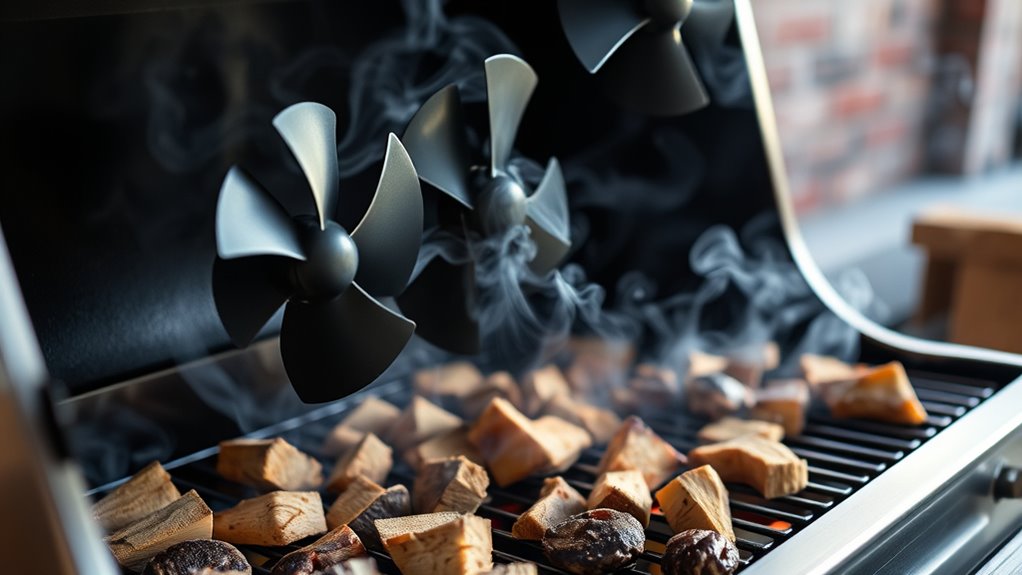
Smoke plays a crucial role in BBQ by imparting flavor, aroma, and texture to the meat. When you generate smoke from burning wood or charcoal, tiny particles settle onto the surface of your meat, creating a delicious, smoky crust. This process not only enhances taste but also helps retain moisture inside, keeping your meat tender. The type of wood you choose influences the flavor profile—hickory offers a strong, smoky taste, while fruit woods like apple provide a mild, sweet aroma. Proper smoke management is essential for achieving the desired flavor balance and avoiding overly bitter or harsh notes. Smoke also contributes to the formation of a desirable bark, adding texture. Understanding how smoke interacts with your meat allows you to control the intensity and character of the flavor, making your BBQ uniquely savory and aromatic. Additionally, controlling smoke density ensures that the flavor remains balanced and does not become overpowering, while considering environmental impacts can help reduce harmful pollutants released during smoking. Implementing effective ventilation techniques can improve smoke quality and safety during cooking. Proper ventilation and fire management are also key components to maintain consistent smoke quality.
Optimal Fan Placement for Effective Smoke Control
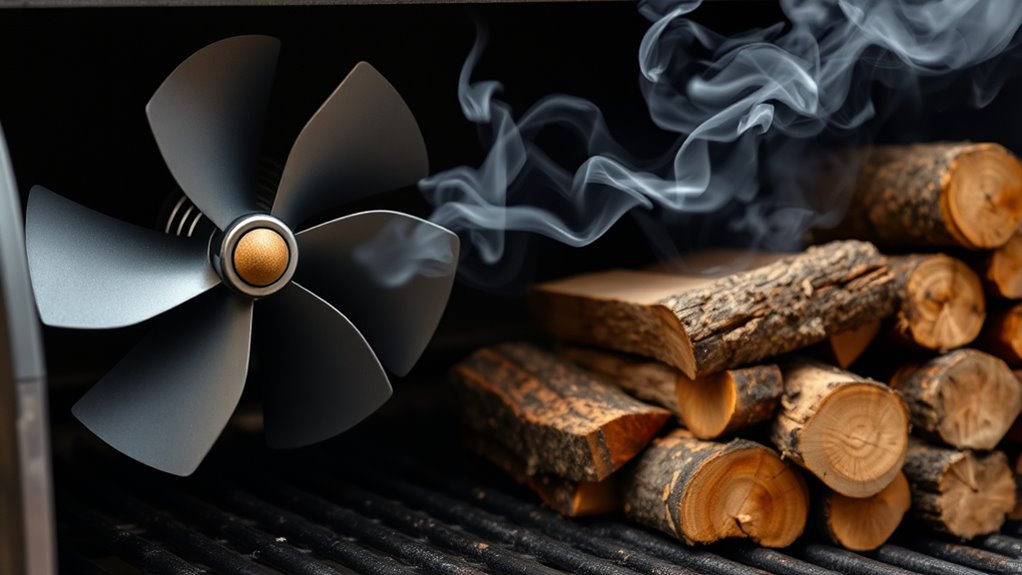
Proper fan placement is essential for managing smoke effectively during BBQ, especially when aiming to control its direction and intensity. Position your fan so it blows across the smoker’s opening or vents, helping to redirect smoke away from your cooking area. Placing the fan too close can cause excessive airflow, disrupting temperature stability, while placing it too far may have little effect. Aim for a balance where the airflow assists in dispersing smoke without disturbing the fire or temperature. Experiment with angles and distances to find the sweet spot that pushes smoke in the desired direction while maintaining steady heat. Remember, the goal is to optimize smoke flow, not to blow out the fire or create turbulence that hampers cooking. Additionally, understanding the contrast ratio of your setup can help you better assess how lighting and smoke interact, ensuring your smoker remains effective in different conditions. Maintaining proper airflow is also crucial for temperature consistency, helping you achieve evenly smoked and flavorful results. Adjusting airflow appropriately can also maximize flavor extraction, resulting in a more enjoyable BBQ experience. Proper airflow management can also influence fuel efficiency, making your smoking process more sustainable and cost-effective. To enhance your control, consider how airflow dynamics impact overall smoke management and flavor.
Selecting the Right Fan for Your Smoker Setup
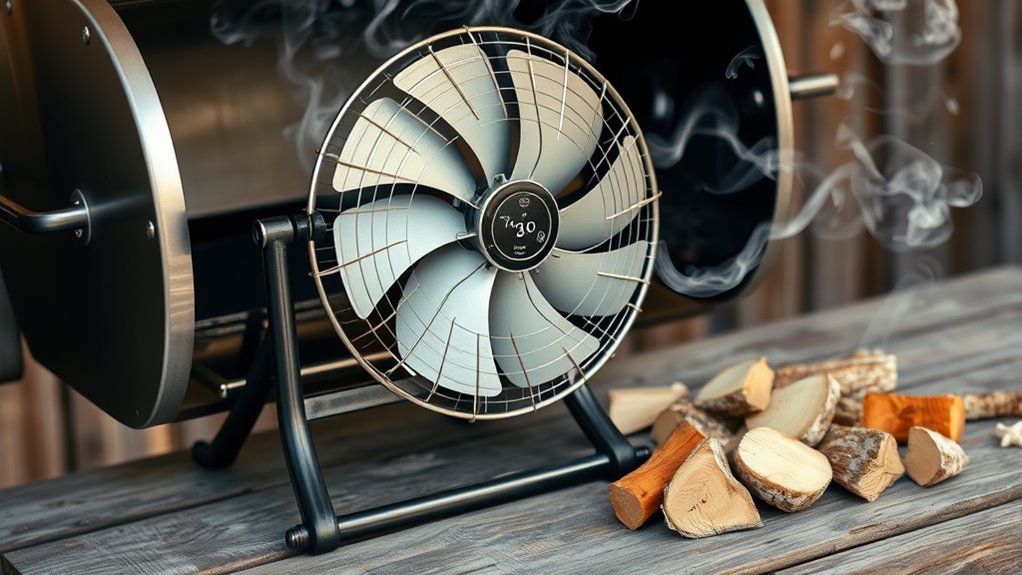
Choosing the right fan depends on matching its power and speed to your smoker’s size and airflow needs. You also need to guarantee the fan type is compatible with your setup to avoid operational issues. Getting these points right will help you maintain ideal smoke control and improve your BBQ results. Additionally, considering space optimization in your smoker area can facilitate better airflow management and easier maintenance. Implementing proper tuning techniques can further enhance your smoker’s performance and consistency.
Fan Power and Speed
Selecting the right fan for your smoker setup is essential to maintaining consistent smoke and temperature control. Fan power and speed directly influence airflow, affecting how evenly heat and smoke circulate. Too much power can create overly aggressive airflow, drying out meat or causing temperature spikes. Too little might result in insufficient smoke or uneven cooking. Adjusting fan speed helps you fine-tune airflow based on your setup and weather conditions. Here’s a quick guide:
| Fan Power | Effect |
|---|---|
| Low | Gentle airflow, slow cook |
| Medium | Balanced, steady heat |
| High | Strong airflow, quick adjustments |
| Fan Speed | Suitable for |
| Slow | Fine-tuning, delicate setups |
| Fast | Rapid response, high airflow |
Additionally, understanding website performance metrics can help you optimize your setup by analyzing how airflow adjustments impact cooking results.
Fan Type Compatibility
Since different fans have varying designs and power sources, it’s important to match the fan type with your smoker setup to guarantee ideal airflow and durability. Choosing the right fan depends on compatibility with your equipment and your smoke management needs. For example, if you have a small, portable smoker, a compact USB or battery-operated fan might be sufficient. Larger smokers may require more powerful AC-powered fans to ensure consistent airflow. Consider how you’ll power the fan, its size, and noise level to fit your setup. Additionally, check if the fan’s airflow direction aligns with your desired smoke circulation. Properly matching the fan type ensures efficient smoke control and longevity of your equipment. Be sure to verify headphone compatibility if you plan to use electronic components alongside your smoker setup to avoid electrical issues. Being aware of family background can also provide insight into the cultural heritage influencing your equipment choices. Understanding fan efficiency, in particular, can help you select a model that offers optimal airflow while conserving energy. For example, choosing a fan with high performance ratings can improve your smoke management system’s overall effectiveness. Moreover, assessing personality test insights can help tailor your approach to smoke management based on your personal preferences.
Types of Wood and Their Flavor Profiles
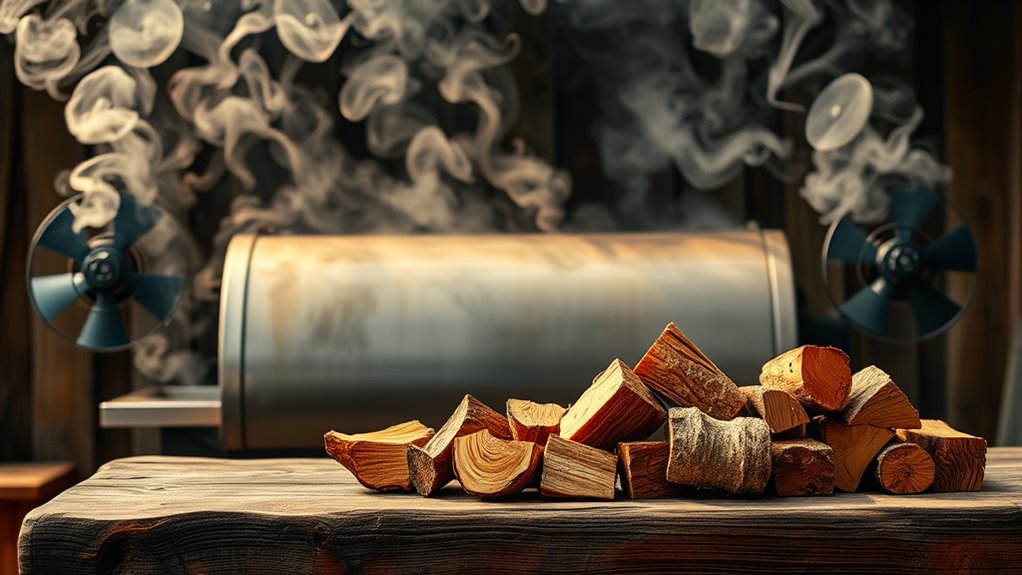
Different types of wood bring unique flavors to your barbecue, so choosing the right one matters. Fruitwoods add sweet, fruity notes, while hardwoods like oak and hickory provide longer-lasting smoke. Aromatic woods, such as cedar or alder, can introduce subtle, distinctive aromas to enhance your meat. Incorporating smoke quality considerations can further elevate your grilling experience. Additionally, understanding the nutritional content of different woods can help you select options that complement your culinary goals. Recognizing the wood burning characteristics can also influence how well the smoke infuses your food and the overall flavor profile. Being aware of the best wood types for smoking can help you tailor your smoking process for optimal results, especially when considering the fire management techniques for consistent smoke production.
Fruitwoods’ Sweet Notes
Fruitwoods are prized in barbecue for their naturally sweet and aromatic notes that enhance the flavor of smoked meats. These woods impart a subtle, fruity sweetness that complements and elevates the natural taste of your meat. When using fruitwoods, you’ll notice a gentle, fragrant smoke that adds depth without overpowering. Popular options include apple, cherry, peach, and plum, each offering unique nuances. Apple wood provides a mild, sweet flavor perfect for pork and poultry. Cherry wood adds a rich, fruity aroma that pairs well with beef. Peach and plum woods give a slightly more floral, sweet profile, enhancing lighter meats. Incorporate these woods carefully to balance sweetness and smoke, creating a delightful flavor profile for your barbecue.
- Apple: Mild, sweet, ideal for pork and poultry
- Cherry: Rich, fruity, enhances beef and poultry
- Peach: Floral sweetness, complements lighter meats
- Plum: Subtle, fruity aroma for delicate flavors
Hardwoods for Longevity
While fruitwoods add delicate sweetness and aroma to your barbecue, hardwoods are the go-to choice when you need extended smoke sessions without frequent reloading. Hardwoods burn longer and provide consistent heat, making them ideal for prolonged cooks. Popular options include oak, hickory, and maple, each offering unique flavor profiles and longevity. Oak provides a mild, versatile smoke, while hickory adds a bold, smoky intensity. Maple offers a subtle sweetness, complementing pork and poultry. Choosing the right hardwood depends on your flavor preference and cooking duration. Additionally, selecting quality firewood can significantly impact the efficiency and flavor of your smoking process. Being aware of AI security concerns related to digital tools can also help you protect your data while researching or purchasing supplies online. Proper storage of your firewood ensures it remains dry and ready for use, which is essential for optimal burning. Below is a quick guide to help you select the best wood for longevity:
| Hardwood | Flavor Profile | Best For |
|---|---|---|
| Oak | Mild, versatile | Long cooks, beef |
| Hickory | Strong, smoky | Pork, ribs |
| Maple | Sweet, subtle | Poultry, fish |
| Cherry | Mild, fruity | General use |
| Ash | Light, clean | Extended sessions |
Aromatic Wood Varieties
Aromatic wood varieties are prized in barbecue for their ability to impart distinctive, fragrant flavors that enhance the natural taste of your meat. These woods release aromatic compounds that add complexity and depth, making your dishes more memorable. When choosing aromatic woods, consider their unique flavor profiles and how they complement your meat. Some woods burn quickly and produce strong aromas, while others smolder slowly, offering subtler notes. Using aromatic woods wisely can elevate your barbecue experience, creating a well-rounded flavor profile. Keep in mind, the right combination depends on your preferred flavor intensity and the type of meat you’re grilling. Experimenting with different varieties allows you to discover the perfect aromatic balance for your smoked creations.
- Applewood: sweet, fruity aroma
- Cherry: mild, sweet, and fruity
- Alder: light, delicate flavor
- Pecan: rich, nutty aroma
How to Choose the Best Wood for Different BBQ Styles
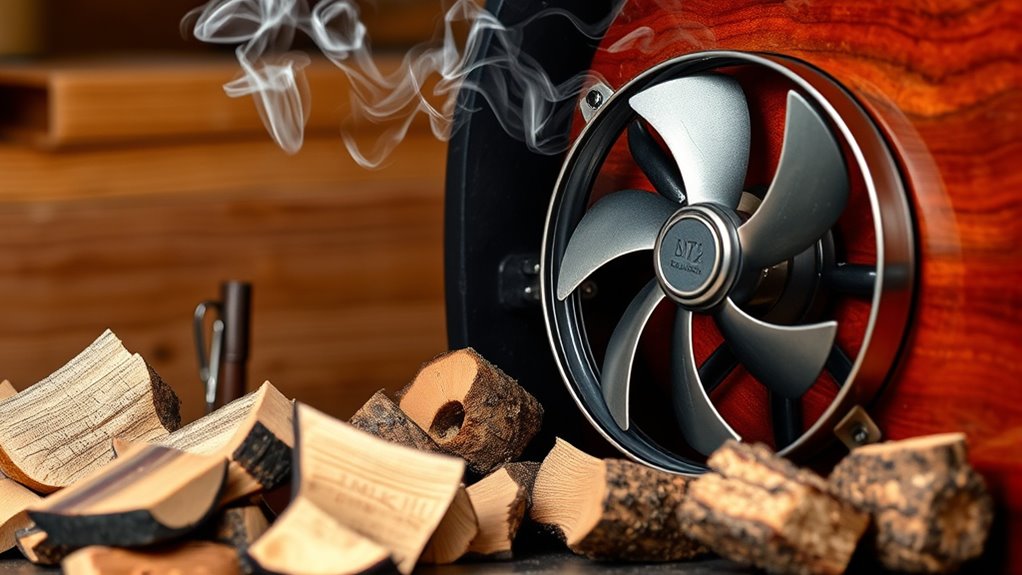
Choosing the right wood is essential for achieving authentic flavors in your BBQ, as different woods impart distinct tastes and aromas suited to various styles. For smoked brisket or beef, hardwoods like oak or hickory work well, providing a rich, smoky depth without overpowering the meat. If you’re grilling chicken or pork, fruitwoods such as apple or cherry add a subtle sweetness that complements lighter flavors. For a stronger smoky punch, mesquite is ideal, especially for Texas-style BBQ, but use it sparingly to avoid bitterness. When preparing ribs, consider a blend of woods to balance sweetness and smokiness. Always match your wood choice to your desired flavor profile and the meat’s characteristics, experimenting to find what best enhances your BBQ style.
Techniques for Managing Smoke Density and Flow
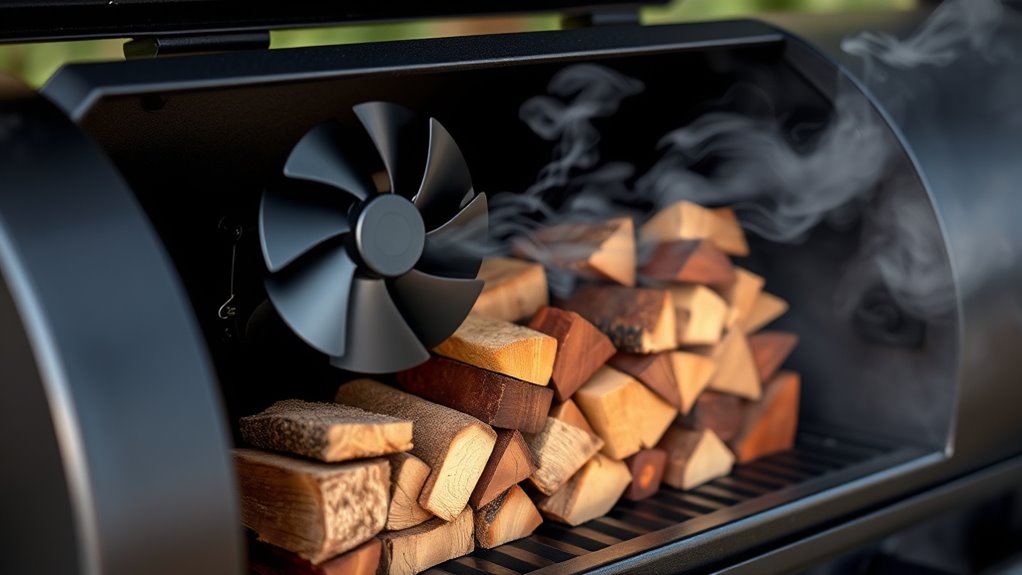
Controlling smoke density and flow is essential for achieving the perfect balance of flavor and texture in your BBQ. To do this, adjust your vents to regulate airflow, ensuring the smoke remains steady and not overwhelming. Use a thin, blue smoke rather than thick, billowing white smoke for better flavor. Position your fan strategically to encourage even circulation without creating turbulence. Also, consider the size and placement of your wood chunks or chips to control smoke output.
- Keep vents partially open to avoid too much airflow
- Use a fan to direct smoke toward the meat evenly
- Limit wood use to prevent excessive smoke density
- Observe smoke color and flow, adjusting as needed
Troubleshooting Common Smoke Management Issues
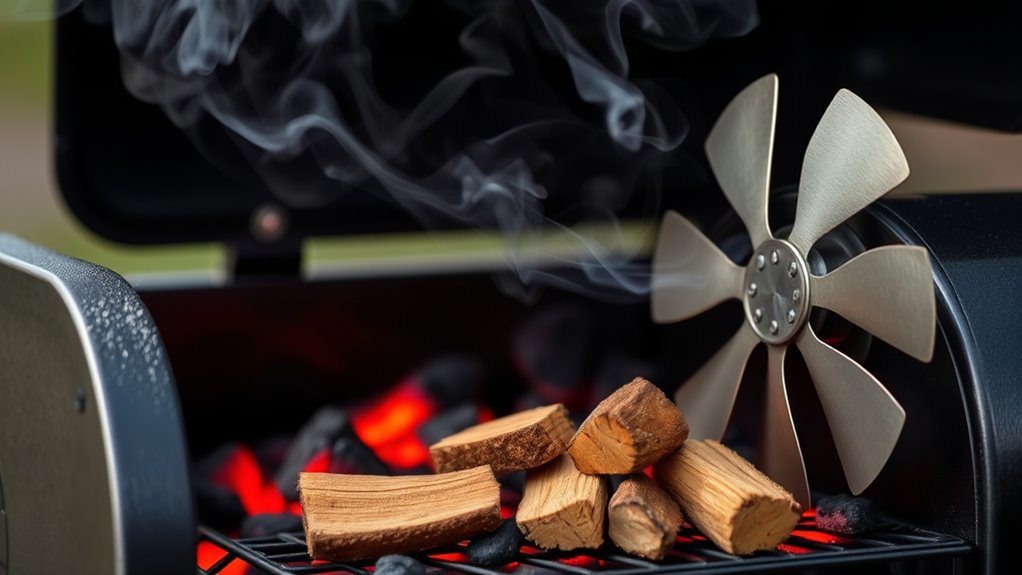
When smoke behaves unpredictably during your BBQ, troubleshooting becomes essential to maintain the desired flavor and texture. If your smoke is too thick or billows excessively, check your airflow—ensure vents are open enough and your fan placement promotes steady flow. If the smoke is weak or barely visible, verify that your wood is properly seasoned and adding enough fuel. Inconsistent smoke often comes from uneven heat; adjust your fire or fan settings to stabilize temperature. Sometimes, the problem lies in wood choice—hardwoods like hickory or oak produce better smoke than softwoods. Finally, avoid over-smoking, which can lead to bitter flavors. By systematically checking airflow, fuel quality, wood choice, and fire management, you can troubleshoot most common smoke issues effectively.
Frequently Asked Questions
How Does Ambient Weather Affect Smoke Circulation and Flavor?
Ambient weather considerably influences smoke circulation and flavor during your BBQ. Wind can disperse smoke unevenly, affecting how flavors develop and reach the meat. Humidity impacts how smoke clings to surfaces—high humidity helps trap smoke, intensifying flavor, while low humidity allows smoke to dissipate quickly. Temperature changes can alter airflow, making it harder to control smoke flow. To get consistent results, keep an eye on weather and adjust your setup accordingly.
Can Alternative Fans Improve Smoke Control in Large or Custom Smokers?
Ever wondered if alternative fans can boost smoke control in large or custom smokers? They definitely can. By choosing more powerful or strategically placed fans, you improve airflow, ensuring even smoke distribution and better temperature regulation. This means you get consistent flavor and less risk of hot spots. Are you maximizing your smoker’s potential? Upgrading your fans can make all the difference, making your smoking process more precise and flavorful.
Are There Safety Concerns With Different Wood Types During Smoke Management?
When considering safety concerns with different wood types, you should know that some woods release harmful chemicals or toxins when burned. Hardwoods like oak and hickory are generally safe, but softwoods like pine may produce more creosote and unpleasant fumes. Always guarantee proper ventilation and avoid burning treated or painted woods. Using the right wood helps you minimize health risks and keeps your smoke flavorful and safe for everyone enjoying your BBQ.
How Does the Smoker’s Design Influence Smoke Flow and Fan Placement?
Imagine you’re designing a smoker with a vertical chamber. Your goal is ideal smoke flow, so you position the fan at the bottom to draw air upward. Proper design guarantees even smoke distribution and efficient exhaust. The shape and airflow paths influence fan placement and wood loading. You need to contemplate how your smoker’s internal layout directs smoke, making sure the fan helps create consistent, flavorful smoke throughout the cooking process.
What Maintenance Is Required to Keep Fans and Airflow Systems Working Effectively?
To keep your fans and airflow systems working effectively, you should regularly clean out any dust, grease, or debris that accumulates. Check for any loose wires or worn parts and tighten or replace them as needed. Confirm fans are operating smoothly without unusual noises. Lubricate moving parts periodically and verify that vents and ducts aren’t obstructed. Proper maintenance guarantees consistent airflow, helping you achieve perfect barbecue results every time.
Conclusion
Remember, a little smoke goes a long way—it’s all about balance. By placing your fan correctly, choosing the right wood, and mastering flow techniques, you can keep your BBQ flavorful without overdoing it. Don’t be afraid to experiment and troubleshoot along the way. As the saying goes, “A bird in the hand is worth two in the bush.” With patience and practice, you’ll perfect your smoke management and elevate your barbecue game.










